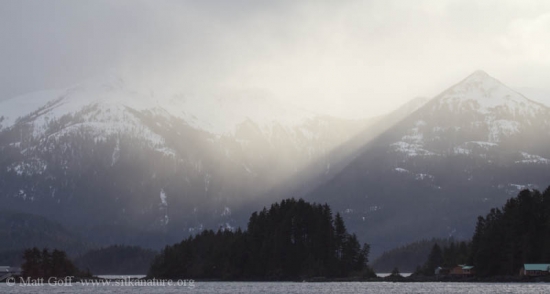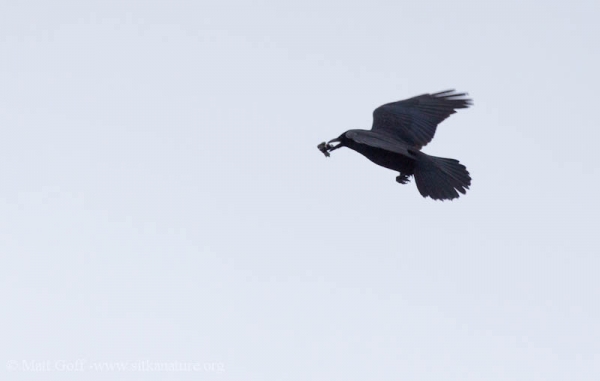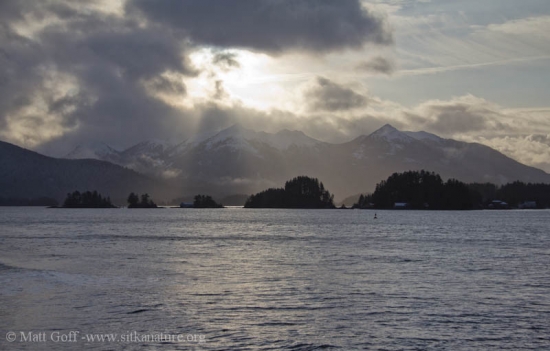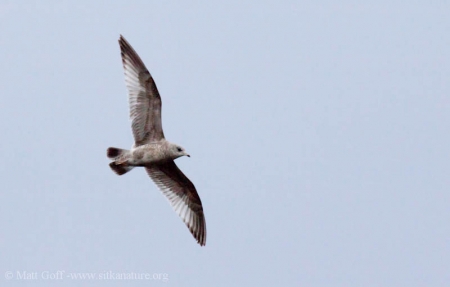Walked down to Totem Park with the kids again today. It was pretty rainy for much of the time we were there, though the rain stopped and skies lightened a bit before we left.
flora
Plants
Snowy Day at Totem Park
I got an e-mail this morning from someone who reported seeing a dozen or so geese off the point at Totem Park this morning. She said it was dim and she didn’t have binoculars so couldn’t see them too well, but it looked like they might not have white cheeks, and might be worth checking out. I took this as motivation to get out of the house – something I might not have done otherwise.
By the time I headed out, skies were getting darker and snow was starting to fall. When I reached the park snow was falling heavily. Between the wind, snow, and moderately low tide, I couldn’t see the water at the end of the park, and I didn’t really want to wander out into the stiff breeze with blowing snow. Instead, I spent a little more time on the trail, gave some attention to the two species of alder, then walked over to the river mouth, and finally to the point, by which time the snow was starting to let up.
I walked out on the flats and was able to approach some of the 100 or more crows fairly closely. They seemed to be foraging for invertebrates and eating snow. It was fun to watch (and try to photograph) them flying up with mussels (I think) and dropping them to crack them open. I got pictures of several different individuals, but not a good full sequence for any particular time. I sorted the gallery pictures below so it’s in order, even though the pictures are from 2 or 3 different birds. One particular crow allowed me to approach quite closely as it was eating snow. I was interested in this, since Rowan had just told me a couple of days ago that she was able to see the crows eating snow at the park.
After heading back to the trail, I stopped to take pictures of 5 different alder trees. I like to try and notice differences between the species of alder (Alnus rubra and Alnus viridis) – and I think I found another one today. It seemed to work pretty well for the trees I could find at the park today, anyway.
Winter Sun at Totem Park
Bright skies this morning lured me into taking a walk with Connor and Rowan down to Totem Park. However, by the time we were leaving, it seemed to be totally overcast and a light snow was falling. We walked down to Lincoln Street and found things to be pretty quiet, both on land and on the water. As we reached the park, the sun started to break out from behind the clouds, offering hope of a chance to accumulate a bit of sun exposure – something that has been sorely lacking in this significantly wetter than usual December.
By the time we got to the battle site part of the loop, the sun had broken out of the clouds, and it felt noticeably warm standing on the beach where I could get the full effect of the direct sun as well as the strong reflections off the water. I just stood there for a couple of minutes enjoying the warmth before Rowan informed me there were some shorebirds around the corner. Going to investigate, I discovered the wind blowing from the east – though not especially strong – was sufficient to make it feel quite chilly, despite the sun. I later retreated back to the calmer location – having the good excuse that I wanted to try and get some pictures of the redpolls I had seen adjacent to the beach there.
One of the things I’ve been keeping an eye out for is a good representative of Fomitopsis pinicola (one of two or three different species often referred to as Bear’s Bread). Despite it being very common, I have previously only taken pictures of this shelf fungus that were unusual in some way. Today I noticed one growing on a spruce trunk right at the start of the beach-side of the west loop. A little further down the path, I took a picture of the somewhat similar Heterobasidion annosum, as well. This can sometimes form a shelf, and in such cases may look quite similar to the Fomitopsis, but unlike Fomitopsis, it often grows flat, not forming a shelf at all.
Despite there being few birds around, I did see some things of interest. Species-wise, at least a couple of Common Redpolls were working the alders with a handful of Pine Siskins. Redpolls were absent last winter, and this is only the second time I’ve seen any siskins in the past several months. Also of note were at least a couple of Rock Sandpipers in with the Black Turnstones, and a probable Red-tailed Hawk first spotted by Rowan (who told me she saw the red tail – I just saw a brief glimpse of it before it disappeared behind the trees).
While attempting to photograph the siskins and redpolls, I was also treated to some activity of a small group of Barrow’s Goldeneye right near the shore, but I think I’ll post on that separately, as I would like to wrap this up.
Walk to Totem Park
Around noon (shortly after the 12.38 high tide) I went for a walk down along Lincoln Street and through the park. I was thinking with the high tide there might be some birds fairly close to land, but it was much quieter than I hoped. I did see some Harlequin Ducks and gulls by the park. Black Turnstones on the beach, and Red-breasted and Common Mergansers off-shore and in the river, respectively.
Weather was quite gray this morning, though it was starting to get brighter by the time I left. While out walking, the clouds broke up and I saw a brief bit of sun and blue sky between the rain and hail squalls.
Water-logged Dandelion
On an wet August hike up Indian River valley, I found this dandelion (Taraxacum officinale) looking quite robust in a pool of standing water. Dandelion is an introduced species and considered fairly invasive. It’s the only introduced species I’ve noticed occurring with any regularity in locations that haven’t been directly impacted by humans (and usually … Read more
Bear Trail Mystery
On a November hunting trip we followed a fairly long bear trail for a while. At one point along the trail we came upon a section leading up to a sign tree that stood out to me. I’ve seen several other trails where there were the worn in foot prints and noticed different vegetation at … Read more



